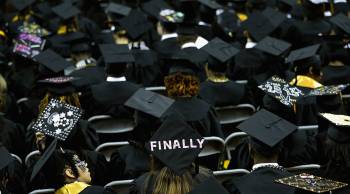Among the most troubling effects of the economic stall and moribund job market is how hard it hits young college graduates. These are the people with the knowledge and the skill to grow the economy with energy and innovation. Yet more and more college graduates will continue to struggle repaying their loans.
However, the truly worrisome sector is graduates from for-profit colleges. Two recent reports highlight just how ominous are the numbers.
Colleges and universities have kept raising tuition and fees at a pace twice the rate of overall consumer inflation. Imagine, higher education price hikes dwarfed even home price increases during the bubble years.
Home prices plunged during the bust and are still down. College presidents continued raising the tab for earning a college sheepskin as if nothing had happened. With family incomes stagnant over the past decade students have been steered toward taking on ever larger loans. That’s the experience of plenty of freshman who will be heading off to college in a few weeks.
The total amount of student loan debt outstanding is now greater than the nation’s total credit card bill. We get emails and calls all the time on Marketplace Money from recent graduates struggling to meet the monthly repayment tab.
A recent study by Education Sector, a higher education think-tank, highlights student loan debt. Kevin Carey and Erin Dillon, respectively policy director and policy analyst, have created a borrowing-to-credential ratio. The ratio is the amount of money borrowed by undergraduates divided by the total number of degrees awarded. The results in *Debt to Degree: A New Way of Measuring College Success *confirm that students are borrowing more overall.
However, their research shows that there are vast differences among states and types of schools. For instance, Iowa State student s borrowed $20,237 per degree earned while at Florida State graduates borrow $10,888. Yet the total cost of attending each institution is about the same–Iowa costs a mere $165 more. Many elite colleges and universities are making sure that low-income and middle income students don’t graduate with too much debt, either.
From a personal finance point of view, their data confirms that it pays for families and their students to shop around for the best deal.
From a public policy point of view, the data screams that the epicenter of potential student loan borrowing problems is with for-profit colleges. Look at this chart: It paints a disturbing picture about students and debt at for profit institutions of all kinds.
Moody’s, the rating agency, in its July 2011 report, *Student Lending’s Failing Grade *highlights how the default rate has exploded at for-profits compared to other institutions of higher education.
Enrollment at for-profit institutions represents less than 10% of total enrollment, but growth has more than tripled over the past decade.
Don’t get me wrong: A college education is well worth it for many young adults. It’s the entrance exam into a decent job and career over a lifetime.
That said, the debts being taken on in the for-profit sector look like its too much for too many–and the problem could get worse as the economy continues to stagnate.
There’s a lot happening in the world. Through it all, Marketplace is here for you.
You rely on Marketplace to break down the world’s events and tell you how it affects you in a fact-based, approachable way. We rely on your financial support to keep making that possible.
Your donation today powers the independent journalism that you rely on. For just $5/month, you can help sustain Marketplace so we can keep reporting on the things that matter to you.


















